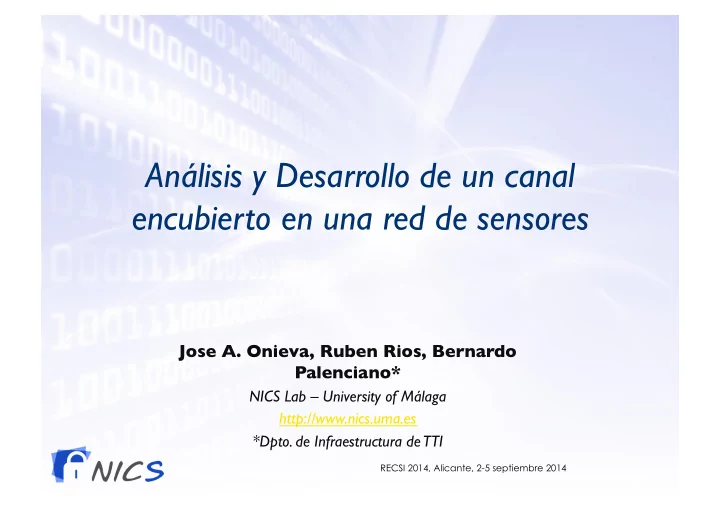

Análisis y Desarrollo de un canal encubierto en una red de sensores ! Jose A. Onieva, Ruben Rios, Bernardo Palenciano* ! NICS Lab – University of Málaga ! http://www.nics.uma.es ! *Dpto. de Infraestructura de TTI ! ! RECSI 2014, Alicante, 2-5 septiembre 2014
Agenda ! ! ! A Fictitious Scenario ! ! Covert Channels and WSNs ! ! Requirements needed for operation ! ! Protocol Design & Implementation ! ! Detectability ! ! Current and Future Work ! 1
A Fictitious Scenario ! ! Alice works in a company that uses a WSN to monitor the levels of water conditions in the Strait of Gibraltar for mussel farming. ! – At the same time, this company benefits from its strategic business location to carry out an illicit transport of substances in containers. ! ! Alice and Bob want to uncover the smuggling ! – Alice needs to tell Bob the " container that carries the stash ! – No suspicion (at all) should be raise in " the company ! ! RECSI 2014, Alicante, 2-5 septiembre 2014
Covert Channels ! From serranoprada.com RECSI 2014, Alicante, 2-5 septiembre 2014
Covert Channels ! ! A covert channel is a form of hidden communication between processes ! – Encryption hides the communication content only ! ! Two main categories of covert channels: ! – Storage channels exploit ambiguous protocol specs. Some well-known network-based covert channels: ! • Covert_TCP (TCP/IP), Ozyman (DNS), HIDE_DHCP (DHCP), LOKI2, PingTunnel (ICMP), FirePass (HTTP). ! – Timing channels exploit the modulation of behaviour (e.g. sending times of network messages) ! • [Girling CG., 1987], [Luo et al., 2007], etc. ! RECSI 2014, Alicante, 2-5 septiembre 2014
Wireless Sensor Networks ! RECSI 2014, Alicante, 2-5 septiembre 2014
WSNs ! ! A wireless sensor network (WSN) is a distributed system with resource-constrained devices (nodes) whose main objective is to monitor a physical phenomenon. ! ! One-hop vs. multi-hop ! ! Event-driven vs. query-based vs. continuous event notification ! ! Networks already deployed ! RECSI 2014, Alicante, 2-5 septiembre 2014
Requirements ! RECSI 2014, Alicante, 2-5 septiembre 2014
Requirements ! ! Detectability ! ! Integrity ! ! Communication ! ! Bandwidth ! ! Energy consumption ! RECSI 2014, Alicante, 2-5 septiembre 2014
Design ! RECSI 2014, Alicante, 2-5 septiembre 2014
Design Decisions ! ! We choose to design a covert timing channel based on the modulation of the data transmission intervals ! – Changing the collection times is not unusual ! – Requires no software modifications ! emisor receptor ! Sender and recipient agree upon a " � H t = 2 t = 2 H � suitable character-time coding ! O t = 3 t = 3 O – E.g. Huffman coding of Spanish language ! � L L t = 1 t = 1 � A – Default interval t if no transmission ! t = 4 t = 4 A ! The sender is at the base station " and the recipient is an external observer ! RECSI 2014, Alicante, 2-5 septiembre 2014
Implementation ! RECSI 2014, Alicante, 2-5 septiembre 2014
Implementation Elements ! ! Contiki OS for sensors ! – Use COOJA simulator for testing ! ! Sniffer ! – “Simulated” with packet broadacast in COOJA simulator ! – Existing solutions for WSN sniffers (e.g. Jackdaw). ! ! Physical sensors for tests ! – Tmote sky de Motiev ! ! Default transmission interval established in 15 secs ! RECSI 2014, Alicante, 2-5 septiembre 2014
Implementation ! ! From experiments we observed some problems ! – The sniffer has a precision error around 1 ~ 2 seconds ! – Packet collisions limit the integrity and bandwidth of the channel ! RECSI 2014, Alicante, 2-5 septiembre 2014
Implementation ! ! We (partially) solved these limitations at the expense of reduced bandwidth ! – Time distance between characters is of 5 seconds ! – Each character is transmitted 3 times ! – Use a CHANGE character for resynchronization in case of double symbols. ! ! Current bandwidth = 10 bytes / 38 minutes ! RECSI 2014, Alicante, 2-5 septiembre 2014
Detectability ! RECSI 2014, Alicante, 2-5 septiembre 2014
Detectability ! ! Intrusion Detection Systems in WSNs analyse ! – Modifications to the data collected by sensors ! – Code integrity verification ! – Data exchanged between sensors ! ! The only suspicious activity is the modification of the transmission interval for a time period ! – But the base station is assumed to be trustworthy ! – The suspicion level can be lessened by reducing the bandwidth ! ! Search of timing patterns are not straightforward in continuous-event monitoring ! RECSI 2014, Alicante, 2-5 septiembre 2014
Current and Future Work ! ! Improving the bandwidth of the solution ! – Different (clusters of) motes having different transmission intervals ! • Synchronization becomes complex ! • How does this affect detectability? ! ! ! We are studying new ways of hiding information ! – Packet header fields ! – Routing paths ! – Packet order of arrival ! RECSI 2014, Alicante, 2-5 septiembre 2014
The End ! RECSI 2014, Alicante, 2-5 septiembre 2014
Recommend
More recommend